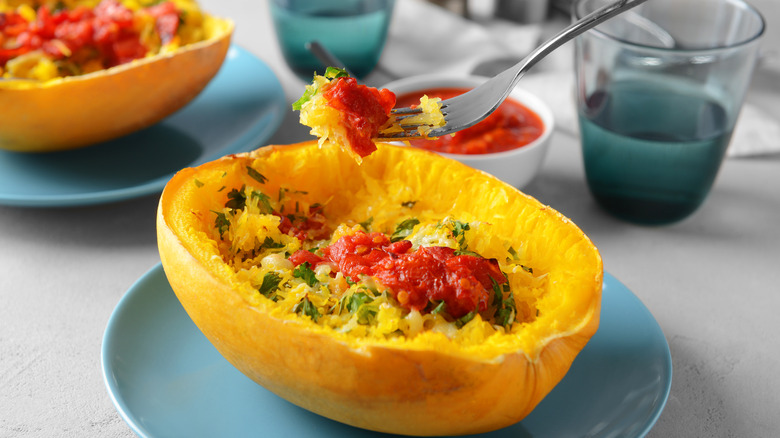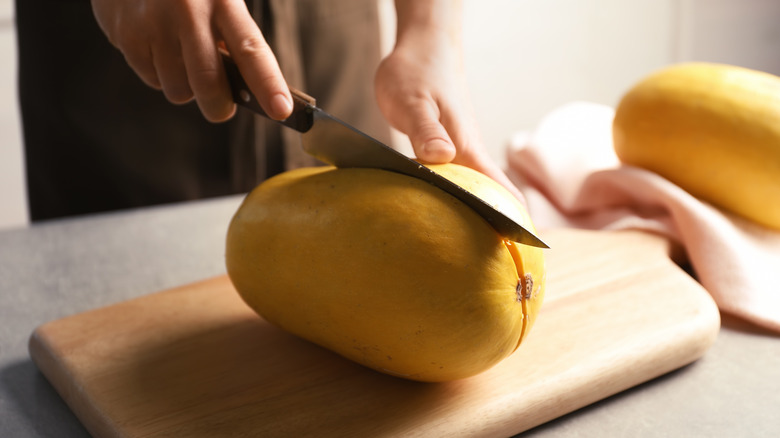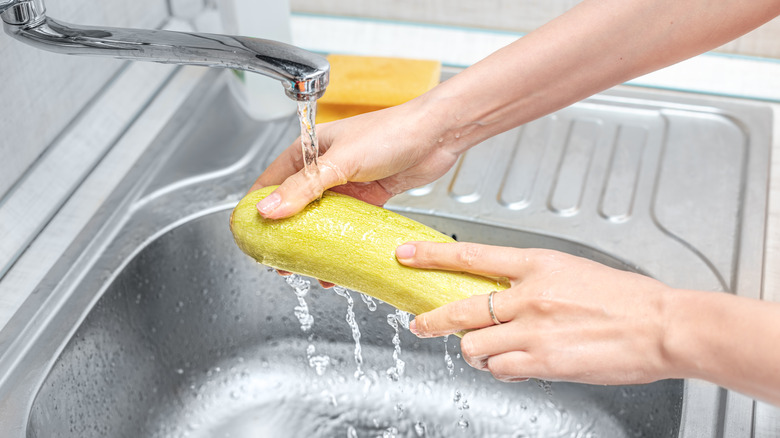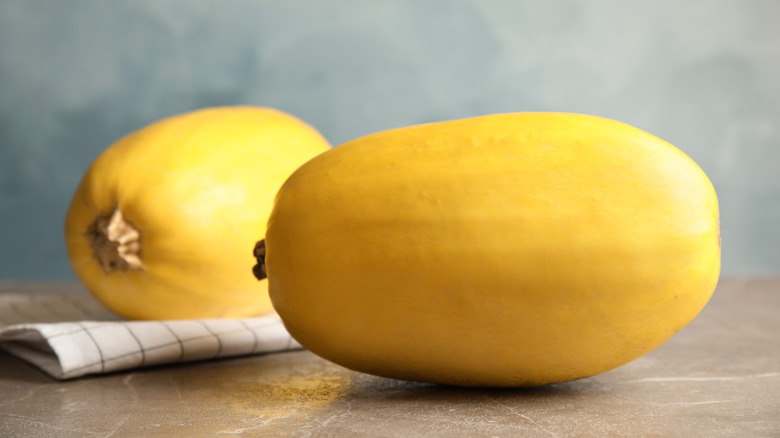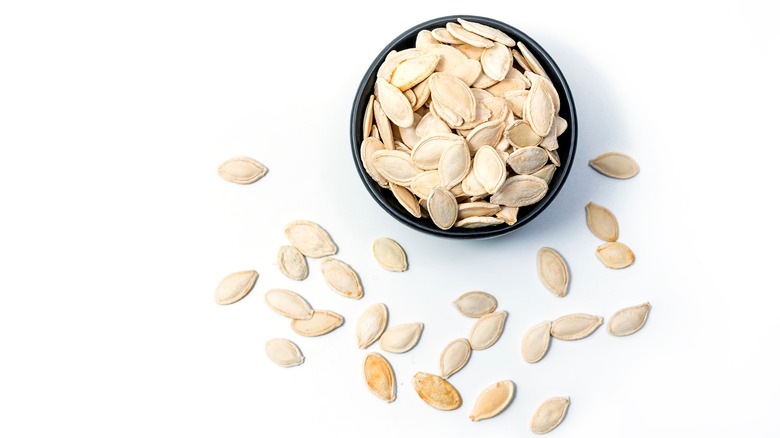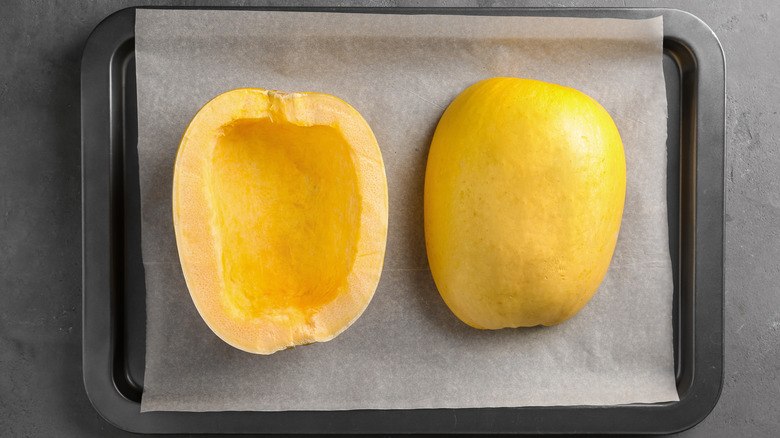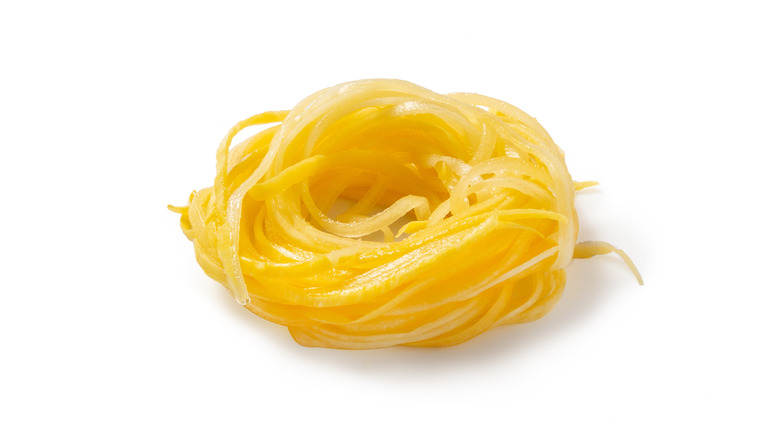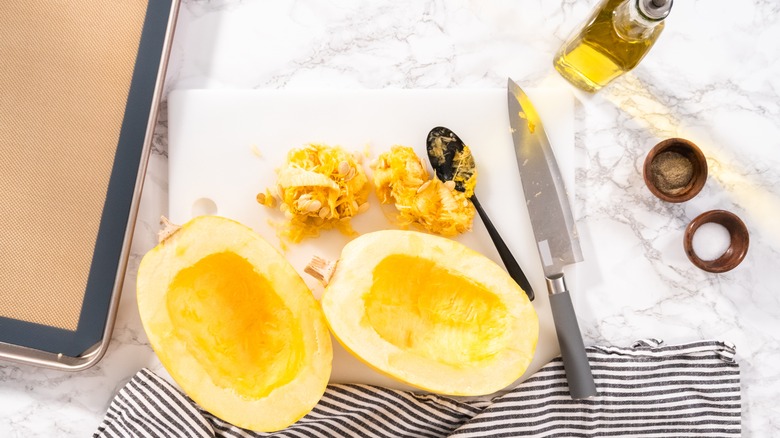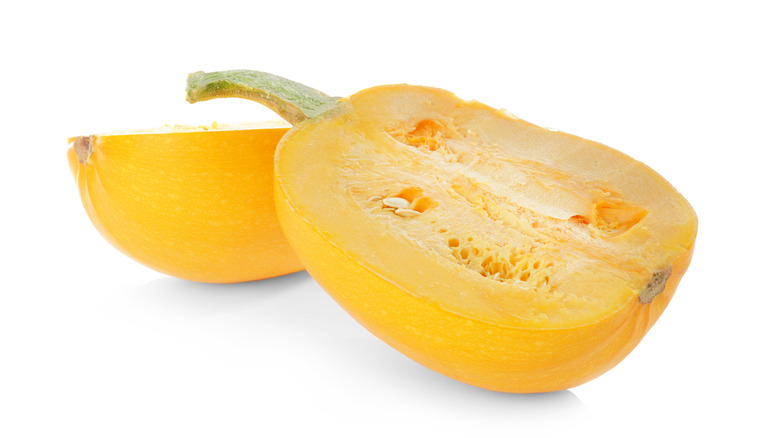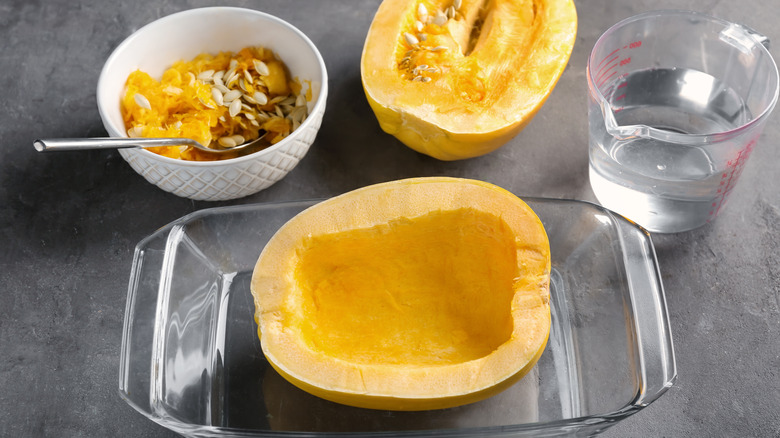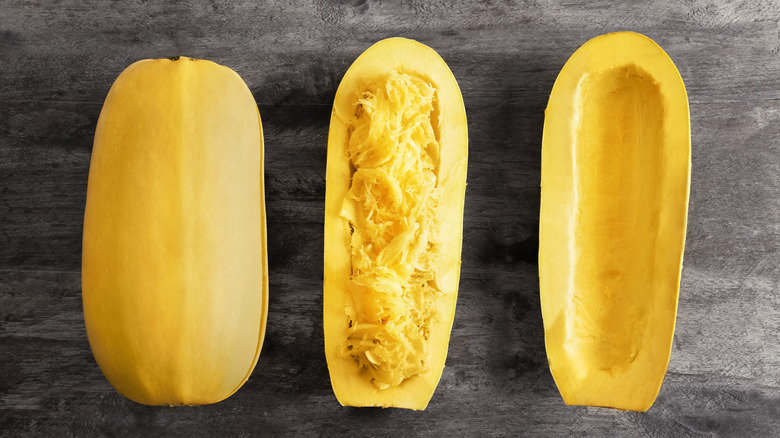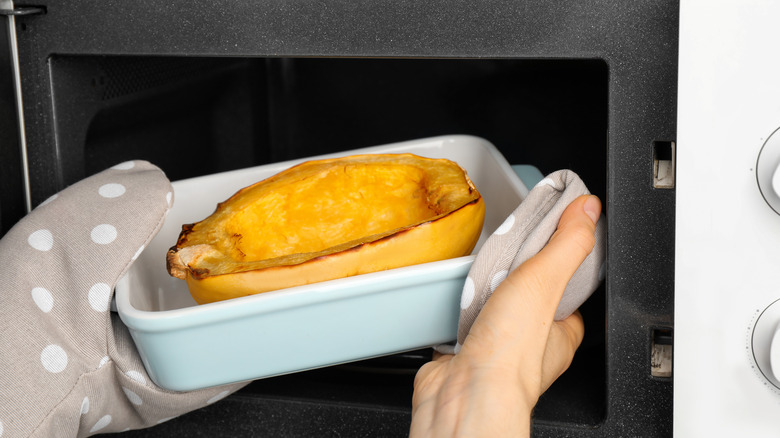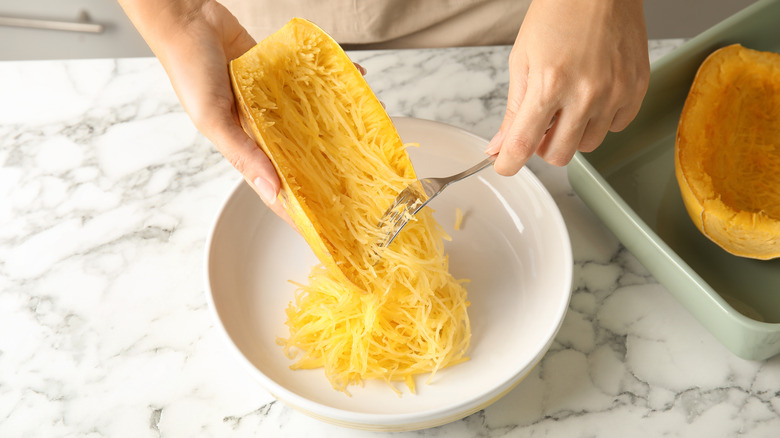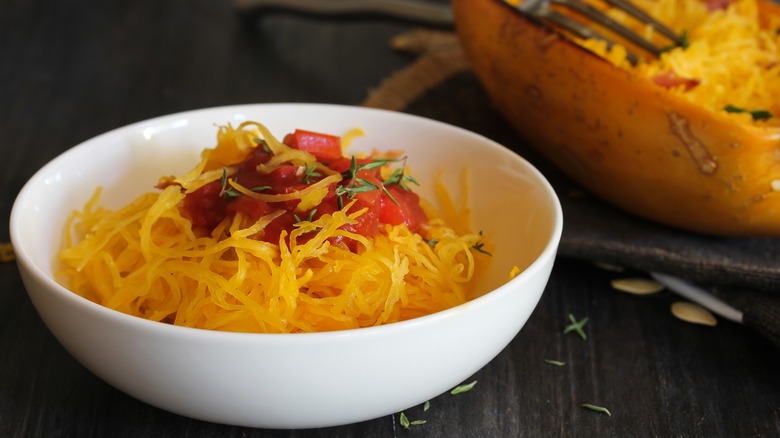The Biggest Mistakes Everyone Makes When Cooking Spaghetti Squash
If you're looking to add more healthy foods to your diet, consuming more spaghetti squash is a fantastic way to go about it. This bright yellow, oval winter squash is quickly become one of our favorite varieties because of its unique texture. A cooked spaghetti squash shreds will turn into dozens of spaghetti-like "noodles" when probed with a fork, transforming into a perfect low-carb replacement for pasta. This winter squash is not only low calorie and high fiber, but it also boasts a ton of nutritional benefits, from vitamin C and vitamin B6 to antioxidants like beta carotene (via Cleveland Clinic).
While spaghetti squash cooks very similarly to other types of popular winter squashes, it does have a few distinguishing characteristics that you'll want to pay attention to. Once you know the best ways to cook spaghetti squash and the trick behind making it easier to cut, you'll be a squash-cooking pro in no time. (And no, it doesn't always have to be eaten like pasta.)
Cutting spaghetti squash without a sharp knife
While we generally recommend using a sharp knife whenever you're prepping vegetables, it's especially important when cutting into spaghetti squash. According to the University of Florida's Institute of Food and Agricultural Sciences Gardening Solutions, squashes are generally categorized into two groups: Summer squash, which have thin skins, and hard-rinded winter squash, which can withstand long-term storage. Spaghetti squash falls into the latter category, and that rind is thick enough to be challenging to cut.
While you can roast a spaghetti squash whole without cutting it, we don't necessarily recommend it (more on that in a minute). Instead, it's best to cut the squash in half or into rings before cooking it. If your knife isn't sharp enough, the blade won't cut easily and you'll have to use an immense amount of force to get through — creating a dangerous situation if you happen to slip. So do yourself a favor and start with a sharp knife.
In the event that you still can't cut into the raw squash, you can try softening the flesh by poking a few holes in the spaghetti squash with a paring knife, per FoodSmart Colorado. Then, microwave it for three to five minutes to soften the exterior, transferring it back to the cutting board with a pair of potholders to protect your hands from the heat.
Not washing spaghetti squash before cutting it
Spaghetti squash probably isn't the first food most people think of when foodborne illness comes up, but it is possible to get sick from eating spaghetti squash. While winter squash doesn't generally carry the same risk of salmonella and E. coli as meat products, the CDC recommends washing all fruits and vegetables under running water, even if you don't plan to eat the peel. This food safety practice extends to spaghetti squash, so you'll want to rinse the entire yellow surface before cutting into it.
Healthline explains that fruits and vegetables are touched by many hands between the time they're harvested and when they make it into your grocery cart. It's safe to assume that at least one of those hands was unclean and could potentially contaminate the squash's exterior. Bacteria like listeria can be found in soil and contaminate winter squash, as it did during the 2021 butternut squash recall, reported by Food Safety News. Cutting into a spaghetti squash without washing it first can transfer those contaminants into the flesh inside. Listeria is particularly dangerous to pregnant women, leading to potential miscarriage or premature birth, and it can cause other potentially serious side effects like fever or vomiting (via Mayo Clinic).
Roasting spaghetti squash whole
Remember how we mentioned that you can roast spaghetti squash whole? It's one of the several different ways to cook spaghetti squash, and each will result in a slightly different "noodle" texture. Since spaghetti squash is so difficult to cut, you might be tempted into skipping the whole cutting step and roasting the squash whole instead. While you absolutely can do this, we wholeheartedly recommend against it.
There are a few issues with this cooking method. For starters, it takes much longer to cook a spaghetti squash whole compared to a halved or sliced squash. You're looking at about 35 to 45 minutes, plus 10 minutes to let it cool before cutting into it. Comparatively, a squash cut into rings only takes 20 to 30 minutes with no wait time at the end. Not only that, but you'll have to deal with scooping out those seeds before you can serve, which is notably more difficult when the squash is soft than when it's rock hard. Finally — and most importantly — we've found this method produces the mushiest noodles because the moisture is trapped inside the whole squash as it cooks. Put it all together, and there's a better way to roast spaghetti squash.
Throwing away the seeds
After you've cut into the spaghetti squash, the next step is to remove the seeds. It's certainly not everyone's favorite step — those seeds are stringy and slimy — and most people tend to scoop them directly into the trash bin. While it does take a little bit of extra work, we would urge you to save those seeds. One Green Planet reports that not only are all winter squash seeds edible, but they have fantastic nutritional value, too.
Saving the seeds is as easy as scooping out the pulp and transferring it to a bowl of warm water. Using clean hands, agitate the squash pulp to loosen the seeds from the stringy bits. You don't need to obsessively remove all the flesh, as any stragglers still taste great after the seeds have been roasted. Transfer the seeds to a colander and rinse them with cold water before patting them dry with a clean kitchen towel.
From there, there are several ways to use squash seeds. Roast them like pumpkin seeds for a snack or salad garnish, add them to homemade trail mix or seeded breads, or turn them into seed butter or soup. The possibilities are endless.
Cooking spaghetti squash cut-side up
One of the popular methods for cutting spaghetti squash involves cutting the squash in half lengthwise. The stem is very tough to get through, so it's best to stand the squash on the non-stem end and cut downwards until you reach the cutting board. You'll end up with two boat-like halves that are ready for roasting (once you remove the seeds, of course).
Before you pop the squash into the oven, be sure to position the halves cut-side down on the baking sheet. Like most vegetables, winter squash have a pretty high water content. Harvest to Table lists winter squash as 86 to 89% water, depending on the variety. Some of that water evaporates out during the cooking process, and if the halves are roasted cut-side up, a lot of that moisture would remain inside the boats. The result? Mushy spaghetti squash. Instead, when the halves are roasted cut-side down, the moisture is released and creates steam when it hits the baking sheet, keeping the squash tender and moist without becoming waterlogged.
Not cutting the squash into rings
There's definitely a time and a place to cut spaghetti squash lengthwise. Turning the squash into boats — like with our favorite spaghetti squash lasagna boats recipe — basically creates an edible serving dish. That said, if you're planning to serve spaghetti squash in a bowl or on a serving platter, there's a better way to cut it: into rings. For starters, this method cooks slightly faster (20 to 30 minutes for rings compared to the boat's 30 to 40 minutes). More importantly, we think it tastes better. The rings create more surface area, which allows each ring to become caramelized to deep brown perfection in the hot oven. That adds a subtle sweetness to the finished dish.
You'll want to start by removing and discarding the top half-inch of each end. Then, cut the remaining squash into two-inch rounds. Scrape out the seeds from the center of each round to turn them into a ring. After cooking, you can use a fork to remove the skin and fluff up the flesh, which will turn into a little noodle nest.
Forgetting to season spaghetti squash
Regardless of how you cut spaghetti squash, it's important to season it before popping it in the oven. Winter squash like butternut squash or acorn squash have a strong, sweet flavor, but spaghetti squash isn't as bold. It does boast a slightly sweet characteristic, but it's mostly neutral tasting. That makes it perfect for tossing with a robust tomato sauce as a pasta replacement, but it will taste even better if you give it a little flavor boost before cooking it.
After cutting the spaghetti squash, rub it with a little olive oil or melted butter. Then give it a sprinkle of kosher salt and freshly ground black pepper as a base seasoning. You can stop there if you're planning to serve it with a tasty sauce like pesto or alfredo sauce. For a more herbaceous dish, try seasoning the squash with granulated onion or garlic, chopped herbs like rosemary or oregano, or warming spices like cinnamon and nutmeg. You can also put a few sprigs of fresh herbs underneath the cut pieces to add aromatics to the squash without adding any color.
Not cooking spaghetti squash long enough
According to The Whole Portion, many varieties of winter squash are safe to eat raw, including spaghetti squash. In its raw form, spaghetti squash has a nutty flavor and is full of nutrients. If you choose to eat spaghetti squash raw, you'll want to be sure to cut it into very small pieces as it has a crunchy texture that would be hard to get through if served as large chunks. That said, it's not necessarily healthier to eat it raw, and the texture obtains a noticeable improvement when it's cooked. Furthermore, it's much more difficult to cut into those small pieces when it's raw.
Choosing to serve raw spaghetti squash is one thing, but it's quite another thing to serve it undercooked. When it hasn't been cooked long enough, the flesh won't release like noodles, causing them to be crunchy and unpleasant. To check the doneness of spaghetti squash, pierce the squash with a fork. If the flesh flakes off like spaghetti noodles, give it a taste to make sure the texture is soft and isn't overly crunchy. You can continue to cook it in five to 10 minute increments until it reaches the desired consistency.
Cooking spaghetti squash in water
Many recipes call for placing spaghetti squash in an inch of water before cooking it in the oven. While adding a little water is necessary for an Instant Pot recipe — which requires a small amount of liquid to function properly — it's unnecessary when roasting spaghetti squash. Winter squash have a naturally high water content, so the spaghetti squash will produce its own moisture as it cooks.
Adding water when roasting squash in the oven will muddy the flavors of the squash, especially if you're placing the cut squash directly into the water. This extra water can also cause the resulting noodles to turn out mushy. Instead, skip the water step and roast the squash directly on a baking sheet lined with aluminum foil or parchment paper.
If you read this step too late and the squash is already in the oven, there is a way to remove a little moisture if your squash accidentally turns out too mushy. Try this hack from Clean Plates: Remove the squash strands with a fork, transfer them to a colander, and gently press down on them with a paper towel.
Roasting spaghetti squash at a low temperature
Some foods benefit from low-and-slow cooking temperatures while others turn out better when they're roasted at the oven's high heat settings. When it comes to spaghetti squash, it's much better to choose a high oven temperature. Most recipes start with the oven at 400 degrees Fahrenheit, but recipes for spaghetti squash rings call for even higher temperatures, like 425 degrees Fahrenheit. This high heat level promotes caramelization, which begins at 338 degrees (via Webstaurant Store).
It all comes down to something called the Maillard reaction — the chemical process that occurs when sugars and amino acids encounter heat. At high temperatures, the top of the cut spaghetti squash will caramelize and crisp up. That finish would turn out a little weird with regular spaghetti noodles, but it adds an appealing texture to winter squash. If you were to roast the squash at lower temperatures, the squash will still cook and soften, but it will become too soft. Without the caramelized top, you'll end up with an uninspired mushy texture that's bound to disappoint.
Using the microwave as a shortcut method
Cooking spaghetti squash is pretty simple, but it's not exactly the quickest cooking item. A whole spaghetti squash can take over 40 minutes to finish in the oven, and halving or cutting it into rings can still take up to 30 minutes. So it's definitely tempting to cook spaghetti squash in the microwave, where it will only take 15 minutes. Unfortunately, this shortcut method results in bland, mushy flesh that's not as tasty as other cooking methods.
If you're looking for a better timesaving method, try using the Instant Pot for spaghetti squash. You'll want to cut the squash in half crosswise instead of lengthwise to ensure it will fit inside the pot, and you'll still want to scoop out the seeds before cooking like you would with the oven method. From there, add a cup of water to the Instant Pot, place the halves on the steaming basket, and close the lid, setting the pressure cook timer to seven minutes. When the timer expires, release the pressure manually and get ready to enjoy a tasty steamed spaghetti squash.
Using a spaghetti squash after it's gone bad
Like most winter squash, spaghetti squash will probably last a while after you bring it home from the farmers market or grocery store. According to Bonnie Plants, every variety is unique, and spaghetti squash should last for up to four to five weeks when stored in proper conditions (50 to 55 degrees Fahrenheit with a relative humidity of 60 to 70%). Your home pantry is likely a little hotter than that, so Does It Go Bad anticipates you probably have less than a month to use spaghetti squash when you get it home from the store.
That's a long time, but it would be a mistake to use spaghetti squash once it's started going bad. Some small unsavory spots can be cut away, but you'll want to toss the squash if it feels mushy, soft, or hollow. These could be signs of mold, but these squashes won't taste very good even if the blemishes aren't directly harmful to your health. Purdue University advises throwing away spaghetti squash with large brown spots, which is a sign of black rot.
Eating spaghetti squash if it tastes extremely bitter
If you finish cooking your spaghetti squash and it turns out extremely bitter, toss it in the garbage before eating any more. Serving it may cause you and your guests to get food poisoning! According to Simplemost, winter squash belong to the flowering gourd family cucurbitaceae, which also includes summer squash, zucchini, melons, and cucumbers. While it's very rare, the fruits in this family contain a toxic compound called cucurbitacin E (yes, squash is a fruit, not a vegetable). The compound is usually present in small enough quantities that it's not harmful to humans, but there are some factors, like cross-pollination, that can cause it to increase.
A few bites are enough to make you very sick, so stop eating immediately if the spaghetti squash is unpleasantly bitter. Symptoms of toxic squash syndrome include dizziness, stomach pain, nausea, diarrhea, or vomiting. It may also lead to hair loss several weeks after being poisoned.
Only serving spaghetti squash as pasta
Everyone's favorite way to serve spaghetti squash is as a pasta replacement. This isn't a bad idea by any means. Cooked spaghetti squash flesh flakes off to form noodles that closely resemble spaghetti pasta without the carbs or gluten. So it's a no-brainer to combine spaghetti squash with marinara and meatballs, alfredo sauce, bolognese, or turn it into lasagna. But with such a versatile ingredient, it would be a mistake not to think outside the box. Spaghetti squash is delicious in a number of other preparations, so feel free to explore if you get bored with Italian cuisine.
You'll almost forget spaghetti squash is a vegetable if you roll it up in a tortilla and make a burrito with squash instead of rice. You can also combine the cooked strands with egg to make latkes, or egg and flour to make fritters. If you squeeze out the excess water, you can transform the noodles into a gluten-free crust for pizza or garlic bread, too.
